

The Complete Guide to "useradd" Command in Linux - 15 Practical Examples. We all are aware about the most popular command called ‘useradd‘ or ‘adduser‘ in Linux.
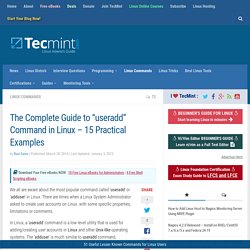
There are times when a Linux System Administrator asked to create user accounts on Linux with some specific properties, limitations or comments. In Linux, a ‘useradd‘ command is a low-level utility that is used for adding/creating user accounts in Linux and other Unix-like operating systems. The ‘adduser‘ is much similar to useradd command, because it is just a symbolic link to it. In some other Linux distributions, useradd command may comes with lightly difference version.
Command line - Create default home directory for existing user in terminal. Samba In Ubuntu Linux – Adding Samba Users » Liberian Geek. This is the second post of our series about installing, configuring and managing Samba in Ubuntu Linux.
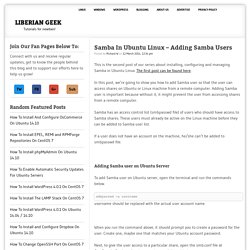
The first post can be found here. In this post, we’re going to show you how to add Samba user so that the user can access shares on Ubuntu or Linux machine from a remote computer. Adding Samba user is important because without it, it might prevent the user from accessing shares from a remote computer. Securing Your Linux Server. By Jon Buys - Jun. 10, 2013Comments (3) Mark Kedgley has a succinct overview of recommended steps to take to harden a linux server over at Ezine Articles.
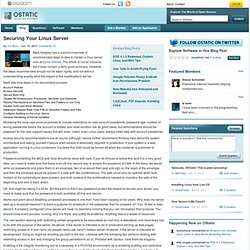
The article is not all inclusive, but it does contain a fairly good summary. However, the steps recommended should not be taken lightly, and not without understanding exactly what the impact of the modifications will be. Mark lists nine steps in his recommend process: Account Policies Access Security Secure Boot Only Disable All Unnecessary Processes, Services and Daemons Restrict Permissions on Sensitive Files and Folders to root Only Disable SUID and SGID Binaries Implement Regular/Real-Time FIM on Sensitive Folders and Files Configure Auditing on the Linux Server General Hardening of Kernel Variables Access security recommendations are all sound, although I would further recommend thinking hard about the system architecture and asking yourself if secure shell access is absolutely required in production.
Set Up a VNC Linux Server in 5 Easy Steps. Virtual Network Computing (VNC) allows you to log into a full desktop on a remote server (as opposed to just opening windows on your local machine, as with X11 over SSH).
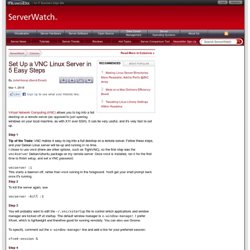
It can be very useful, and it's very fast to set up. Step 1 Tip of the Trade: VNC makes it easy to log into a full desktop on a remote server. Follow these steps, and your Debian Linux server will be up and running in no time. Linux 101: Easy VNC server setup. I’ve had this request a number of times lately — so I thought it was time to write up an easy how-to on setting up a VNC server on your Linux box.
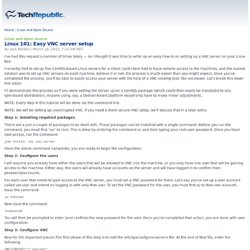
I recently had to set up five CentOS-based Linux servers for a client. Said client had to have remote access to the machines, and the easiest solution was to set up VNC servers on each machine. Believe it or not, the process is much easier than you might expect. Once you’ve completed the process, you’ll be able to easily access your server with the help of a VNC viewing tool, like vncviewer. Let’s break this down into steps. VNC Remote Desktop on Linux. Set Up VNC on Ubuntu in Four Steps. Ubuntu Remote Desktop: Built-In, VNC Compatible & Dead Easy. Using Ubuntu Remote Desktop you can have total control over your desktop from any other computer: Linux, Mac or Windows.
You’ll see what’s on that screen and be able to move the mouse and even type. Best of all, the feature is built into the operating system by default, so you won’t have to install a thing. Let’s check it out! 25 Hardening Security Tips for Linux Servers. Everybody says that Linux is secure by default and agreed to some extend (It’s debatable topics).

However, Linux has in-built security model in place by default. Remote Administration with Linux. The next best thing to being there is being able to log into your systems remotely. One of the great things about Linux is the variety of tools you can use to remotely administer your Linux desktop and server systems. From the command line to GUI tools, you can take control of it all right from the comfort of your very own desktop anywhere you happen to be.
I'm going to introduce you to three ways you can remotely administer your desktops and servers: Secure Shell (SSH), Remote Desktop Viewer, and TeamViewer. Once you've completed this article, it will be up to you to decide which method best suits your needs and when. Secure Shell This is, by far, the fastest and easiest method of remotely administering your desktop. Column: Linux Remote Administration Simplified. 11/30/2005 -- The days of physically needing to sit before the computer or server you are working on are quickly dwindling. Whereas proximity once figured directly into response time, you can now perform most administrative tasks from anywhere. Over a decade ago, dial-in capabilities existed, but they were clunky and tried to lock you into a command line interface that involved more pleading and praying than actually administering. The tools today bear scant resemblance to those tools of yesterday.
Connectivity is now done through the Internet instead of the phone line, and are becoming standard with Linux and most other OS versions as well -- eliminating the need for third-party vendors. Remote Linux Admin for Windows Users. Posted April 22, 2008 05:00 PM by Michael Slater Add your comments All the cool kids in the web world these days seem to be using Macs, which have hearts of Unix so are natural complements to Linux-based servers.
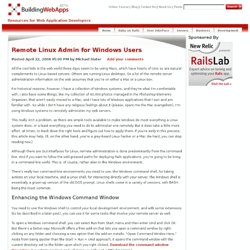
Others are running Linux desktops. So a lot of the remote server administration information on the web assumes that you’re on either a Mac or a Linux box. For historical reasons, however, I have a collection of Windows systems, and they’re what I’m comfortable with. I also have some things, like my collection of 60,000 photos managed in the Photoshop Elements Organizer, that aren’t easily moved to a Mac, and I have lots of Windows applications that I own and am familiar with.
Poor Sysadmin's Guide to Remote Linux Administration. By Kendall Clark 05/16/2002 The Problem Like many free software geeks, I run a one-person Web hosting shop, a combination business, hobby, and community service.
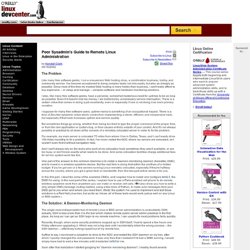
I've become accustomed to doing complex tasks not only easily, but also as cheaply as possible. Since most of the time my modest Web hosting is more hobby than business, I can't really afford to buy expensive -- or setup and manage -- complex software and hardware monitoring solutions. I also, like many free software geeks, have a perverse, somewhat mysterious need for uptimes to be as long as possible. I suppose for many free software users, uptime mania is something of an occupational hazard. But sometimes things go wrong, whether from being too tired to type the proper command at the proper time, or from the rare application or system bug, or from causes entirely outside of your control. In this first part, I describe some of the available DMDs, and I explain how to install and configure monit , the DMD I'm using.
YaST Remote Administration - openSUSE. Tagline: openSUSE sitesinden About Remote Administration is used to allow the machine to be administered remotely from another machine.
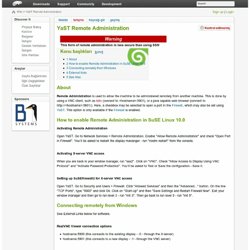
This is done by using a VNC client, such as kdrc (connect to <hostname>:5901), or a java capable web browser (connect to Here, a checkbox may be selected to open a port in the Firewall , which may also be set using YaST . Remote Administration with VNC - Rivendell Wiki. From Rivendell Wiki To remotely administer a Rivendell system it is usually necessary and desirable to be able to access the desktop being displayed on the local monitor (i.e. display :0).

While the process for doing this can vary among the Linux distributions, these examples will hopefully point you in the right direction. I will assume that you have already installed the packages that are mentioned below. NOTE: Port 5900 must be open if a firewall is used. Debian GNU/Linux 7.0 Code Name "Wheezy" Server Installation Guide. The Debian Project was founded in 1993 by Ian Murdock. Debian Linux is one of the most popular and freely available Operating System developed by Debian Developers around the world. They are involved with various activities viz. maintaining software repositories, graphic design, legal analysis, software licenses, documentation, web & ftp site administration etc.
Debian supports several Desktop Environment like GNOME, KDE Plasma Desktop and Applications, Xfce, and LXDE. Debian is available in 70 languages, and supporting a huge range of computer types. The project team proudly released Debian 7.0 version (code name “Wheezy“) on 04 May 2013. Remote Administration. Often times I find myself in a familiar situation. Either I need to administrate a machine remotely, or I have 6 machines at my desk without enough room for 6 sets of monitor, mouse, and keyboard. In either situation, a quick, easy, economical solution is what I'm after. SSH Connection Limitations. Limit - Increasing the maximum number of tcp/ip connections in linux. Highly useful Linux commands & configurations. Update, August 2010: A few broken links fixed; thank you, George! Update, September 2008: A few errors corrected; thank you, Umarzuki!
Upgrading Ubuntu via Command Line — LAWR IT. Purpose. Ubuntu 13.04 Linux Server Debuts. Should You Upgrade? Every six months, Ubuntu Linux comes out with a new server release. Ubuntu 13.04 “Raring Ringtail” Server Installation Guide. Ubuntu 13.04 non LTS “ Raring Ringtail ” Server was released on 25 April 2013 . This guide shows installation of recently released Ubuntu 13.0 4 Server with screenshots. This release includes latest and greatest packages, some of them are OpenStack Grizzly Pythan Juju 0.7 Ceph 0.56.4 MAAS 1.3 TMongoDB 2.2.4 OpenvSwitch 1.9.0. Setting Up A Linux File Server Using Samba. Config Windows/Linux File Sharing with Samba.
Preparing Linux Server for use with Windows network. Hi, Ubuntu 13.04 (nginx, BIND, Dovecot, ISPConfig 3. Version 1.0 Author: Falko Timme <ft [at] falkotimme [dot] com> Follow me on Twitter Last edited 04/29/2013 This tutorial shows how to prepare an Ubuntu 13.04 (Raring Ringtail) server (with nginx, BIND, Dovecot) for the installation of ISPConfig 3, and how to install ISPConfig 3.
Installation Guide for Ubuntu 12.04. Installing from CD. During the Server Edition installation you have the option of installing additional packages from the CD. The packages are grouped by the type of service they provide. DNS server: Selects the BIND DNS server and its documentation. Comprehensive Server Guide. This guide will give you an overview for the most common server options in existence and will outline some administration and security guidelines.
Server World - Build Network Server. Debian Server Setup for Beginners. HOW-TO: Part 1 - Complete Guide to Debian File Server Install. HOW-TO: Part 2 - Linux File Server Setup. HOW-TO: Part 3 - Linux File Server on Windows Network. Five Reasons Linux Beats Windows for Servers. The Top 10 Linux Server Distributions. Step 1: Linux appliances. Linux Schools - Server OS. Linux Server Training: Two-Day Hands-On Workshop. Linux Servers. What is Samba? Howto: Adding share in samba server under Linux or UNIX. Samba share permissions simplified. Useful Samba Networking Commands. Lmhosts - The Samba NetBIOS hosts file.